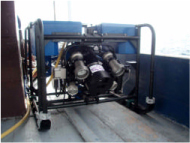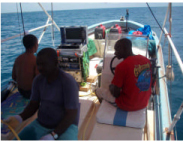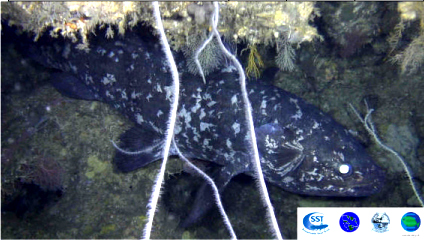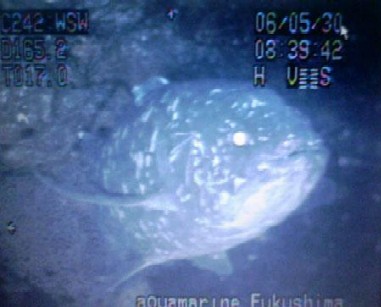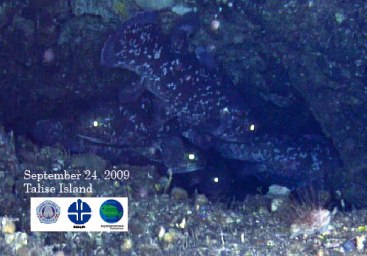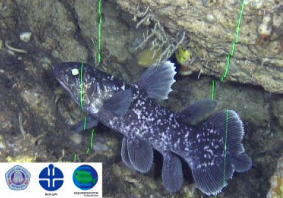The Fukushima Aquarium Expeditions
In 2002, Japan's Fukushima Aquarium (Aquanarine Fukushima) initiated a seven year coelacanth study and capture program, which was inaugurated at a series of conferences and conventions. The aquarium is under the direction of Dr. Yoshitaki Abe. The program, which would involve the combined use of technical divers and a remotely operated vehicle (R.O.V.) targeted the Indonesian coelacanths.
In April of '05, a spectacular series of deep technical free dives, under the direction of Forrest Young of Dynasty Marine Associates Inc, searched for coelacanths in the waters of North Sulawesi, Indonesia. The dive team, assisted by Mark Erdmann , operated in the vicinity of the Indonesian coelacanth discoveries of the 1990's. A depth of 500ft (150m) was reached for brief periods. Although some new and rare species were found, no coelacanths were observed during the dives. As a tribute to the professionalism of the dive team, no serious events or injuries took place. Scientist Mark Erdmann accompanied the team.
An ROV operated by the Aquamarine Fukushima Survey team in conjunction with the divers returned in the fall of '05 to continue searching elsewhere in the area.
On May 30, 2006, off the shore of Boul about 350km west from Manado, Sulawesi, an Indonesian coelacanth was filmed at the depth of 170m, at 830 am, with the ROV. Subsequently five more were seen. The fish were in caves at the same location as those filmed by the Fricke Dive Team in the submersible Jago back in 1999. Dr. Kasim Moosa of the Indonesian Institute for Scientific Research accompanied the survey team. Below is a You tube news video of one of these sightings: (return wth back arrow)
In September and October, 2007, an expedition also funded by Japan's Aquamarine Fukushima and co-sponsored by the African Coelacanth Ecosystem Program (ACEP), The Sustainable Seas Trust, The Tanzania Fisheries Research Institute, and the Tanga Coastal Zone Conservation and Development Programme put an ROV down in the Tanga region and observed nine coelacanths over a five day period. This was the first in situ observation of the Tanzania coelacanths.
In 2008 Aquamarine Fukushima concludes its 4th ROV expedition, this time back in Indonesia, Sulawesi vicinity. An equipment breakdown, ends the expedition early.
During the September 2009 ROV expedition, as many as six individuals were photographed in a single cave ! (Fukusima photo below.)
On October 6th, 2009 the same expedition succeeded in locating and filming a juvenile coelacanth- for the first time!. The fish was found in Manado Bay, North Sulawesi, Indonesia. It was measured by a laser beam from the R.O.V. to be 31.5cm. The fish was positioning itself in a small cave. The expedition leader was Masa Iwata from Fukushima Aquarium.
Overview Indonesian ROV coelacanth investigations (Fukushima Aquarium) and Indonesian coelacanth catches. (Courtesy: Rik Nulens)
1) April 2005 : no coelacanth sightings
2) Photographing total 7 individuals, May/June 2006, Sulawesi island Buol
3) Photographing total 3 individuals, December 2006, Sulawesi Island Buol
4) Photographing 1 individual, June 2007, Malalayang waters, Sulawesi Island Manado
5) No sightings in December 2008, Sulawesi Island north section, ROV breakdown
6) Photographing 1 individual, 14 September 2009, Talise Island, (North) Sulawesi Island
7) Photographing 6 individuals, 24 September 2009, Talise Island, (North) Sulawesi Island
8) Photographing 1 juvenile individual, 6 October 2009, Manado Bay, North Sulawesi
Overview captures Indonesian coelacanths:
1) 18 September 1997, (CCC174), seen by Arnaz & Mark Erdmann-Mehta on a fish market in
Manado Capture site Manado Tua, Kampung Negeri, length ca 130cm
2) 30 July 1998, (CCC175), capture site Manado Papindan village, length ca 124cm, female
3) 19 May 2007, (CCC215), capture site Malalayang, near Bunaken National Marine Park,
length 131cm, female, 25 small eggs (3cm)
4) 25 November 2008, (CCC225), capture site North of Talise Island, Minahasa Utara, North
Sulawesi, length110cm
5) 16 September 2009, (CCC254), capture site Gangga waters in North Sulawesi Province, off
Sulawesi Island, length 114cm
